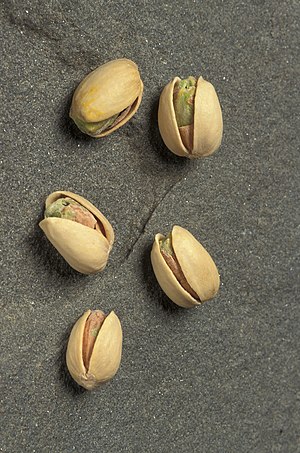Note: This is a project under development. The articles on this wiki are just being initiated and broadly incomplete. You can Help creating new pages.
Pistacia vera
Pistacia vera is a deciduous tree that usually grows 1 - 5 metres tall. It can grows upto 10 metres. The pistachio nut is harvested from the wild and is also often cultivated, especially in western Asia for its edible seed, which is traded internationally. Pistacia vera is threatened in the wild by fruit collection, livestock grazing and cutting. The plant is classified as 'Near Threatened' in the IUCN Red List of Threatened Species(2007).
Contents
- 1 Uses
- 2 Parts Used
- 3 Chemical Composition
- 4 Common names
- 5 Properties
- 6 Habit
- 7 Identification
- 8 List of Ayurvedic medicine in which the herb is used
- 9 Where to get the saplings
- 10 Mode of Propagation
- 11 How to plant/cultivate
- 12 Commonly seen growing in areas
- 13 Photo Gallery
- 14 References
- 15 External Links
Uses
Abdominal ailments, Abscesses, Amenorrhoea, Bruises, Chest ailments, Circulation, Dysentery, Gynecopathy, Pruritus, Rheumatism, Sclerosis of the liver.[1]
Parts Used
Chemical Composition
The comparison of the organic constituents also shows a general similarity but it is observed that the fatty acid composition of the oil is quite different e.g., oleic acid is less (49.5 vs 69.6%) whereas palmitic and linoleic acids are more (13.4 vs 8.2% and 31.8 vs 19.8% respectively).[2]
Common names
| Language | Common name |
|---|---|
| Kannada | |
| Hindi | |
| Malayalam | |
| Tamil | |
| Telugu | |
| Marathi | |
| Gujarathi | |
| Punjabi | |
| Kashmiri | |
| Sanskrit | |
| English |
Properties
Reference: Dravya - Substance, Rasa - Taste, Guna - Qualities, Veerya - Potency, Vipaka - Post-digesion effect, Karma - Pharmacological activity, Prabhava - Therepeutics.
Dravya
Rasa
Guna
Veerya
Vipaka
Karma
Prabhava
Habit
Identification
Leaf
| Kind | Shape | Feature |
|---|---|---|
Flower
| Type | Size | Color and composition | Stamen | More information |
|---|---|---|---|---|
| {{{5}}} |
Fruit
| Type | Size | Mass | Appearance | Seeds | More information |
|---|---|---|---|---|---|
Other features
List of Ayurvedic medicine in which the herb is used
Where to get the saplings
Mode of Propagation
Cuttings of half-ripe wood , Air Layering, Seeds.
How to plant/cultivate
Pistacia vera is a plant of the temperate zone in regions with long hot summers and low humidity.[4]
Commonly seen growing in areas
Mountainous regions, On sandstone soils.
Photo Gallery
References
- ↑ Indian Medicinal Plants by C.P.Khare
- ↑ Chemical constituents
- ↑ [Morphology]
- ↑ Cultivation
External Links
- Ayurvedic Herbs known to be helpful to treat Abdominal ailments
- Ayurvedic Herbs known to be helpful to treat Abscesses
- Ayurvedic Herbs known to be helpful to treat Amenorrhoea
- Ayurvedic Herbs known to be helpful to treat Bruises
- Ayurvedic Herbs known to be helpful to treat Chest ailments
- Ayurvedic Herbs known to be helpful to treat Circulation
- Ayurvedic Herbs known to be helpful to treat Dysentery
- Ayurvedic Herbs known to be helpful to treat Gynecopathy
- Ayurvedic Herbs known to be helpful to treat Pruritus
- Ayurvedic Herbs known to be helpful to treat Rheumatism
- Ayurvedic Herbs known to be helpful to treat Sclerosis of the liver
- Herbs with Seeds used in medicine
- Herbs with Fruits used in medicine
- Habit - Deciduous tree
- Index of Plants which can be propagated by Cuttings of half-ripe wood
- Index of Plants which can be propagated by Air Layering
- Index of Plants which can be propagated by Seeds
- Herbs that are commonly seen in the region of Mountainous regions
- Herbs that are commonly seen in the region of On sandstone soils
- Herbs
- Pages without herbs images




